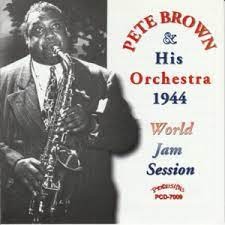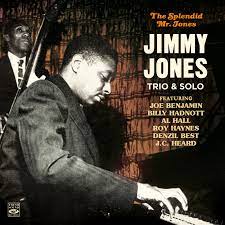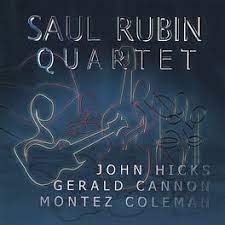
Daily Dose Of Jazz…
Hubert Fol was born in Paris, France on November 11, 1925 and learned piano from an early age through lessons from his mother. He also took lessons in violin and clarinet in his teens and early twenties.
As a saxophonist, Hubert worked with Claude Abadie and Boris Vian and co-founded the Be Bop Minstrels with his brother in 1947. In 1949~1950, he toured Europe and recorded with Coleman Hawkins, then worked with Kenny Clarke and Django Reinhardt before embarking on another European tour with Dizzy Gillespie and Rex Stewart.
In the 1960s his health deteriorated, leading to his playing far less frequently.Saxophonist and bandleader Hubert Fol transitioned on January 19, 1995 in Paris.
More Posts: bandleader,history,instrumental,jazz,music,saxophone

Daily Dose Of Jazz…
James Ostend Brown was born on November 9, 1906 in Baltimore, Maryland and learned to play piano, trumpet, and saxophone in his youth. Professionally known as Pete Brown, he played in New York City with Bernie Robinson’s orchestra in 1928, and played from 1928 to 1934 with Charlie Skeete.
1937 saw him working in the John Kirby band for several years and during the decade he worked with Frankie Newton, who was also a member of Kirby’s band. Brown and Newton recorded often. In addition to recording under his own name, he also recorded with Willie “The Lion” Smith, Jimmie Noone, Buster Bailey, Leonard Feather, Joe Marsala, and Maxine Sullivan.
Pete worked on 52nd Street in New York City in the 1940s, both as a sideman with Slim Gaillard, among others. As a bandleader, he was in Allen Eager’s 52nd Street All-Stars in 1946.
In the 1950s, Brown’s health began to fail, and he receded from full-time performance. He played with Joe Wilder, Big Joe Turner, Sammy Price, and Champion Jack Dupree. He appeared at the 1957 Newport Jazz Festival with Coleman Hawkins and Roy Eldridge. His last appearance was in 1960 with Dizzy Gillespie.
Alto saxophonist and bandleader Pete Brown, who was Cecil Payne and Flip Phillips teacher, transitioned on September 20, 1963 in New York City.
More Posts: bandleader,history,instrumental,jazz,music,saxophone

Daily Dose Of Jazz…
Joseph Rupert Benjamin was born on November 4, 1919 in Atlantic City, New Jersey. He played with many jazz musicians in a variety of idioms. Early in his career he played in the big bands of Artie Shaw, Fletcher Henderson, Sy Oliver, and Duke Ellington.
He went on to work with Hank Garland, Marian McPartland, Louis Armstrong, Jo Jones, Gary Burton, Roy Haynes, Art Taylor, and Brother Jack McDuff.
Never leading a recording session, Joe recorded three dozen albums as a sideman with Bob Brookmeyer, Kenny Burrell, Dave Brubeck, Harry Edison, Duke Ellington, Dizzy Gillespie, Barry Harris, Roy Haynes, Johnny Hodges, Budd Johnson, Roland Kirk, Gary McFarland, Carmen McRae, Gerry Mulligan, Jerome Richardson, Al Sears, Joya Sherrill, Rex Stewart, Sonny Stitt, Buddy Tate, Clark Terry, The Three Playmates, Sarah Vaughan, Mal Waldron and Kai Winding.
Double bassist Joe Benjamin transitioned on January 26, 1974.
More Posts: bass,history,instrumental,jazz,music

Daily Dose Of Jazz…
Saul Rubin was born in New York, New York on October 30, 1950. He studied at Hartt College in Hartford, Connecticut and was taught by jazz masters. He graduated with a Undergraduate Degree in Composition in 1980.
An accomplished guitarist Saul’s career has taken him around the world as well as occupying a place in the New York jazz scene as a musician, producer, impresario and personality. He is a regular member of Roy Hargrove’s Big Band sitting in the guitar seat as well as writing charts for the band.
He has shared the stage and studio with Sonny Rollins, Kirk Lightsey, Victor Lewis, Jonathan Batiste, Bob Cranshaw, Gregory Porter, Renee Fleming, John Hicks, Johnny O’Neal, Hank Jones, Frank Wess, Candido, Winard Harper, Larry Willis, Eric Revis, Sherman Irby, Thomas Chapin, Lew Soloff, and countless others.
Rubin has produced countless recordings and live shows, has run his infamous long- running weekly Jazz Vocalist Series at his ZEB’S performance space and studio, and has played host to many of the world’s greatest jazz artists. This intimate “loft Jazz” style venue became a go-to place for musicians in New York from 2009 to 2016.
His last album as a bandleader aptly entitled, Zeb’s House, is a tribute to the community of great artists, showcasing both his irrepressible sense of humor as well as his signature gritty, purposeful, urbane sensibility, throughout a mix of both originals and standards.
Guitarist, composer and producer Saul Rubin continues to perform and record.
More Posts: composer,guitar,history,instrumental,jazz,music,producer

Daily Dose Of Jazz…
Rodney Charles Levitt was born on September 16, 1929 in Portland, Oregon and studied composition at the University of Washington, where he took his BA in 1951.
He was in the Radio City Music Hall orchestra from 1957 to 1963, and during those years he performed with Dizzy Gillespie, Ernie Wilkins, Kai Winding, and Sy Oliver. In 1959 Rod worked with Gil Evans when his orchestra accompanied Miles Davis. The following year he played with Gerry Mulligan and Mundell Lowe, with Quincy Jones in ‘61, and with Oliver Nelson in 1962.
He recorded four albums as a leader of an octet between 1963-66 and continued to work with this combination into the 1970s, when he played with bassist Chuck Israels.
Later in his career he worked with Cedar Walton and Blue Mitchell, and wrote music for commercials with a company he ran from 1966-1989. The late Seventies saw him teaching at Fairleigh Dickinson, Hofstra University, CUNY, and Hunter College.
Trombonist, composer, and bandleader Rod Levitt transitioned from Alzheimer’s disease in Wardsboro, Vermont at the age of 77 on May 8, 2007.
More Posts: bandleader,composer,history,instrumental,jazz,music,trombone




